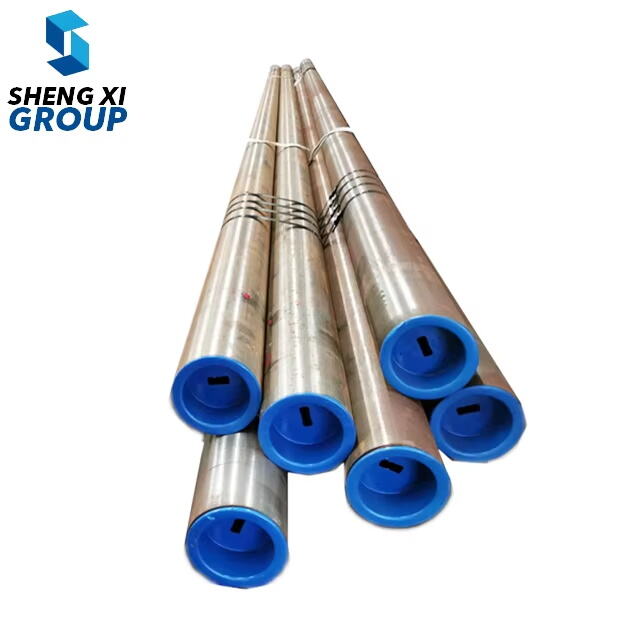The Evolving Role of Alloy Steel in Modern Industry
Driving Forces Behind Alloy Steel Innovation
What drives innovation in alloy steel? Look no further than the constant improvements happening in tech and manufacturing methods. Steel companies are putting serious money into R&D labs these days, trying to come up with alloys that work better and adapt faster to different needs. At the heart of all this innovation lies a simple fact: industries want materials that do things regular steel just can't. Take aerospace engineers who need components that are strong but light, or architects designing buildings that must withstand extreme weather conditions without adding unnecessary weight. The demands keep getting tougher. Meanwhile, material prices keep climbing while competition gets fiercer. Manufacturers have little choice but to tweak their formulas again and again. This mix of technical challenges and economic realities keeps pushing forward the evolution of alloy steels throughout construction, automotive, and countless other fields where performance matters most.
Impact of Global Infrastructure and Automotive Demand
Infrastructure development across emerging markets is boosting demand for quality alloy steel, especially in building projects and transport networks. Meanwhile, car manufacturers are changing their approach as they focus on lighter vehicles and better fuel economy to comply with tougher environmental rules from governments worldwide. Manufacturers have started turning to special alloy blends to handle these new specifications. Looking ahead, the auto industry seems set to be a major driver of increased alloy steel consumption for at least ten years. Some forecasts suggest around 5 percent annual growth just from cars needing stronger but lighter materials. What this means practically is that alloy steels continue to be essential components as both construction sites and assembly lines adapt to modern demands.
Advanced Alloy Composition Breakthroughs
High-Strength Lightweight Formulations
The quest for stronger yet lighter materials has become essential across aerospace and automotive manufacturing. When companies manage to shave off even small amounts of weight from their products, they see real gains in how well those vehicles perform and how much fuel they consume. Engineers are currently working on various alloy combinations, including aluminum mixed with lithium, which appears to offer substantial weight reduction without compromising strength requirements. According to recent data from the industry, some of these new material blends can actually reduce total vehicle mass by around 10 percent, translating into better gas mileage and lower emissions. For carmakers facing increasingly strict environmental regulations and customers who want faster cars without sacrificing safety, these developments represent a game changer. As competition heats up in the market place, we're seeing more manufacturers adopt these advanced alloys as part of their strategy to stay ahead in what promises to be a long-term shift toward lighter, more efficient transportation solutions.
Corrosion-Resistant Alloys for Extreme Environments
In sectors such as maritime operations and chemical processing plants, corrosion resistant alloys just cant be avoided when dealing with tough environmental conditions that eat away at standard materials. Recent improvements in metal mixtures containing nickel and chromium have really made a difference for parts that get battered by harsh elements day after day. Look around any industrial site and we see these special alloys keeping important equipment running longer than before some studies suggest maybe even 30 percent extra lifespan which means fewer breakdowns and less money spent on repairs. Beyond saving cash though, what matters most is having dependable systems especially those where things going wrong could cause serious problems. With companies increasingly operating in tougher locations all the time, there continues to be strong interest in customized materials solutions like these specialized alloys that stand up against corrosion better than anything else available.
Molybdenum-Enhanced Steel Grades
Adding molybdenum to steel alloys makes them much stronger and longer lasting, which works great for parts that need to handle serious stress. Research shows steels with molybdenum additions can actually withstand heat and pressure conditions that would melt regular steel. Oil rigs and gas pipelines really benefit from this because they operate under extreme conditions where equipment failure isn't an option. These improved steel types let companies work in tough locations without constant breakdowns or maintenance issues. Molybdenum's presence in steel mixtures now means better materials for construction projects worldwide, and many manufacturers have started relying on it heavily for their most demanding applications.
Green Manufacturing and Circular Economy
Carbon-Neutral Production Techniques
Steel makers are getting serious about cutting carbon emissions as they work toward greener production methods across the board. A lot of companies have started pouring money into sustainability initiatives lately, trying to shrink their impact on the planet. Some new tech breakthroughs actually cut down CO2 output during alloy steel making by around 30%, something that definitely helps check boxes for international climate targets. When big players team up with green groups, interesting things happen. These partnerships tend to spark real progress in developing cleaner ways to make steel products. While such collaborations do drive innovation forward, there's still plenty of work left before the whole sector meets all those tough standards demanded by customers who care deeply about environmental issues these days.
Scrap Metal Recycling Innovations
Scrap metal recycling is becoming increasingly important for building a circular economy, especially when it comes to making alloy steel. By reusing old materials instead of constantly mining new ones, we cut down on resource consumption quite a bit. Recent improvements in how we sort through scrap and melt it down have actually made recycled steel better quality than before, which fits right into what manufacturers are trying to achieve with their green goals. Some studies show that switching to recycled alloy steel can slash carbon emissions during production by around 70 percent. This means there's real value in keeping these recycling technologies evolving if we want our steel industry to become more sustainable over time without sacrificing product quality or performance standards.
Hydrogen-Based Steelmaking Processes
Steel production that uses hydrogen instead of coal is becoming something big in the alloy steel world, mainly because it cuts down on all those carbon emissions that come from regular steel making. Some test runs happening right now throughout Germany and Sweden are already looking pretty good, with factories reporting around 90 to 95% less CO2 when they switch to hydrogen for their reduction process. Beyond just helping the environment though, this method actually makes hydrogen itself look like it might become one of the main energy sources for the steel industry going forward. If companies start adopting this tech more widely, we could see completely different standards emerge for what counts as green steel production. The industry might finally get closer to that clean manufacturing goal everyone keeps talking about, even if there are still plenty of technical hurdles left to overcome before widespread adoption happens.
Smart Materials Integration
Sensor-Embedded Alloy Systems
Putting sensors into alloy materials is changing the game when it comes to checking structures while they're still in operation. These so-called smart materials give engineers information on things like stress points and heat buildup, something that's really important for planes and bridges among other things. According to various industry reports, these embedded sensors actually help stop disasters before they happen, cutting down on repair bills somewhere around 20 percent in some cases. With this kind of constant watch over their assets, companies can spot problems early and fix them before small issues become big headaches, all while keeping people safe during everyday operations.
Self-Healing Coatings and Adaptive Properties
Self healing coatings are changing how long alloy materials last and work reliably, particularly where things get rough on equipment. Studies show these smart materials actually fix themselves when scratched or cracked, which means parts stay functional longer before needing replacement. Think about car bodies getting dented or airplane wings exposed to extreme weather conditions. Automotive manufacturers, aircraft builders, and even construction firms see real value here because they need stuff that stands up to punishment without constant maintenance. When alloys can mend themselves while still in service, it completely transforms what engineers expect from materials used in tough situations day after day.
Expanding Application Frontiers
Aerospace Component Revolution
Aerospace engineers are turning to alloy steel because it solves some real problems related to aircraft strength while keeping weight down. Recent improvements in how these steels are formulated have allowed manufacturers to create parts that weigh less but hold up better under stress. For planes and spacecraft builders, this combination matters a lot since every ounce saved translates into fuel savings and longer range capabilities. Market analysts expect strong continued interest in specialty alloy steels over the next few years, with estimates pointing toward around 7 percent annual growth. As new aircraft designs push boundaries, the aerospace sector keeps finding new ways to incorporate these advanced materials into everything from engine components to structural elements.
Wind Turbine Structural Solutions
Alloy steel plays a vital role in building wind turbines, particularly because they need to withstand harsh conditions over decades of operation. Recent improvements in metal alloys have made turbine components last longer and work better, something that makes all the difference in generating clean power consistently. Wind energy companies are increasingly turning to these specialized materials as their installations spread across more challenging environments. With renewable energy needs rising fast, manufacturers see alloy steel as almost mandatory for new projects. These stronger materials help towers resist corrosion from salt air near coasts and hold up against extreme weather patterns inland, ensuring turbines keep spinning efficiently year after year.
Medical Implant Compatibility Advances
Alloy steel is finding its way into more medical applications lately, especially when it comes to how well implants work inside the human body. The latest stuff being developed isn't just about surviving in bodily fluids anymore either. These new alloys actually seem to lower rejection rates quite a bit compared to older materials. Some recent lab tests showed that patients who received these newer alloy implants had their devices last longer without complications. For doctors and hospitals, this means fewer follow-up surgeries and better recovery times for patients overall. As manufacturers keep working on making these metals last longer while staying safe for the body, we're seeing real progress in implant technology that benefits everyone involved.
FAQ
What is driving innovation in alloy steel?
Innovation in alloy steel is driven by technological advancements, market demands for unique material properties like high strength-to-weight ratios, and the need to reduce material costs and compete in the market.
Why is there a growing demand for alloy steel in the automotive industry?
The automotive industry is demanding more alloy steel due to the need for lighter materials to enhance fuel efficiency and meet regulatory standards, with a projected annual demand increase of 5% over the next decade.
How do corrosion-resistant alloys benefit industries operating in harsh environments?
Corrosion-resistant alloys offer extended longevity and reduced maintenance costs for industries operating in harsh environments, enhancing reliability and minimizing the risk of failure in critical infrastructure.
What advancements are being made in the recycling of scrap metal for alloy steel production?
Advancements in recycling technologies, such as innovative sorting and melting processes, have improved the quality of recycled alloy steel, cutting the carbon footprint of manufacturing by up to 70% and supporting sustainability.


